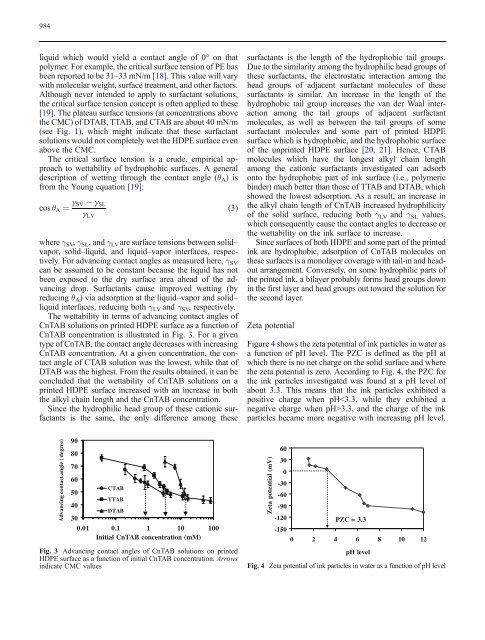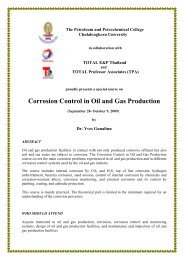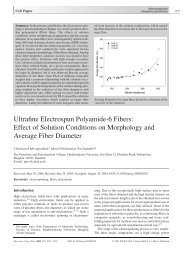Removal of solvent-based ink from printed surface of HDPE bottles ...
Removal of solvent-based ink from printed surface of HDPE bottles ...
Removal of solvent-based ink from printed surface of HDPE bottles ...
Create successful ePaper yourself
Turn your PDF publications into a flip-book with our unique Google optimized e-Paper software.
984<br />
liquid which would yield a contact angle <strong>of</strong> 0° on that<br />
polymer. For example, the critical <strong>surface</strong> tension <strong>of</strong> PE has<br />
been reported to be 31–33 mN/m [18]. This value will vary<br />
with molecular weight, <strong>surface</strong> treatment, and other factors.<br />
Although never intended to apply to surfactant solutions,<br />
the critical <strong>surface</strong> tension concept is <strong>of</strong>ten applied to these<br />
[19]. The plateau <strong>surface</strong> tensions (at concentrations above<br />
the CMC) <strong>of</strong> DTAB, TTAB, and CTAB are about 40 mN/m<br />
(see Fig. 1), which might indicate that these surfactant<br />
solutions would not completely wet the <strong>HDPE</strong> <strong>surface</strong> even<br />
above the CMC.<br />
The critical <strong>surface</strong> tension is a crude, empirical approach<br />
to wettability <strong>of</strong> hydrophobic <strong>surface</strong>s. A general<br />
description <strong>of</strong> wetting through the contact angle (θ A)is<br />
<strong>from</strong> the Young equation [19]:<br />
cos A ¼<br />
SV SL<br />
LV<br />
where γ SV, γ SL, and γ LV are <strong>surface</strong> tensions between solid–<br />
vapor, solid–liquid, and liquid–vapor interfaces, respectively.<br />
For advancing contact angles as measured here, γ SV<br />
can be assumed to be constant because the liquid has not<br />
been exposed to the dry <strong>surface</strong> area ahead <strong>of</strong> the advancing<br />
drop. Surfactants cause improved wetting (by<br />
reducing θ A) via adsorption at the liquid–vapor and solid–<br />
liquid interfaces, reducing both γ LV and γ SV, respectively.<br />
The wettability in terms <strong>of</strong> advancing contact angles <strong>of</strong><br />
CnTAB solutions on <strong>printed</strong> <strong>HDPE</strong> <strong>surface</strong> as a function <strong>of</strong><br />
CnTAB concentration is illustrated in Fig. 3. For a given<br />
type <strong>of</strong> CnTAB, the contact angle decreases with increasing<br />
CnTAB concentration. At a given concentration, the contact<br />
angle <strong>of</strong> CTAB solution was the lowest, while that <strong>of</strong><br />
DTAB was the highest. From the results obtained, it can be<br />
concluded that the wettability <strong>of</strong> CnTAB solutions on a<br />
<strong>printed</strong> <strong>HDPE</strong> <strong>surface</strong> increased with an increase in both<br />
the alkyl chain length and the CnTAB concentration.<br />
Since the hydrophilic head group <strong>of</strong> these cationic surfactants<br />
is the same, the only difference among these<br />
Advancing contact angle ( degree)<br />
90<br />
80<br />
70<br />
60<br />
50<br />
CTAB<br />
TTAB<br />
40<br />
30<br />
DTAB<br />
0.01 0.1 1 10 100<br />
Initial CnTAB concentration (mM)<br />
Fig. 3 Advancing contact angles <strong>of</strong> CnTAB solutions on <strong>printed</strong><br />
<strong>HDPE</strong> <strong>surface</strong> as a function <strong>of</strong> initial CnTAB concentration. Arrows<br />
indicate CMC values<br />
(3)<br />
surfactants is the length <strong>of</strong> the hydrophobic tail groups.<br />
Due to the similarity among the hydrophilic head groups <strong>of</strong><br />
these surfactants, the electrostatic interaction among the<br />
head groups <strong>of</strong> adjacent surfactant molecules <strong>of</strong> these<br />
surfactants is similar. An increase in the length <strong>of</strong> the<br />
hydrophobic tail group increases the van der Waal interaction<br />
among the tail groups <strong>of</strong> adjacent surfactant<br />
molecules, as well as between the tail groups <strong>of</strong> some<br />
surfactant molecules and some part <strong>of</strong> <strong>printed</strong> <strong>HDPE</strong><br />
<strong>surface</strong> which is hydrophobic, and the hydrophobic <strong>surface</strong><br />
<strong>of</strong> the un<strong>printed</strong> <strong>HDPE</strong> <strong>surface</strong> [20, 21]. Hence, CTAB<br />
molecules which have the longest alkyl chain length<br />
among the cationic surfactants investigated can adsorb<br />
onto the hydrophobic part <strong>of</strong> <strong>ink</strong> <strong>surface</strong> (i.e., polymeric<br />
binder) much better than those <strong>of</strong> TTAB and DTAB, which<br />
showed the lowest adsorption. As a result, an increase in<br />
the alkyl chain length <strong>of</strong> CnTAB increased hydrophilicity<br />
<strong>of</strong> the solid <strong>surface</strong>, reducing both γ LV and γ SL values,<br />
which consequently cause the contact angles to decrease or<br />
the wettability on the <strong>ink</strong> <strong>surface</strong> to increase.<br />
Since <strong>surface</strong>s <strong>of</strong> both <strong>HDPE</strong> and some part <strong>of</strong> the <strong>printed</strong><br />
<strong>ink</strong> are hydrophobic, adsorption <strong>of</strong> CnTAB molecules on<br />
these <strong>surface</strong>s is a monolayer coverage with tail-in and headout<br />
arrangement. Conversely, on some hydrophilic parts <strong>of</strong><br />
the <strong>printed</strong> <strong>ink</strong>, a bilayer probably forms head groups down<br />
in the first layer and head groups out toward the solution for<br />
the second layer.<br />
Zeta potential<br />
Figure 4 shows the zeta potential <strong>of</strong> <strong>ink</strong> particles in water as<br />
a function <strong>of</strong> pH level. The PZC is defined as the pH at<br />
which there is no net charge on the solid <strong>surface</strong> and where<br />
the zeta potential is zero. According to Fig. 4, the PZC for<br />
the <strong>ink</strong> particles investigated was found at a pH level <strong>of</strong><br />
about 3.3. This means that the <strong>ink</strong> particles exhibited a<br />
positive charge when pH3.3, and the charge <strong>of</strong> the <strong>ink</strong><br />
particles became more negative with increasing pH level.<br />
Zeta potential (mV)<br />
60<br />
30<br />
0<br />
-30<br />
-60<br />
-90<br />
-120<br />
-150<br />
PZC = 3.3<br />
0 2 4 6 8 10 12<br />
pH level<br />
Fig. 4 Zeta potential <strong>of</strong> <strong>ink</strong> particles in water as a function <strong>of</strong> pH level





